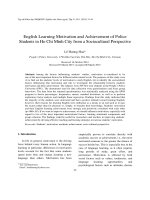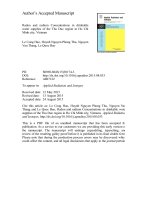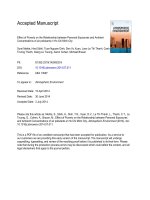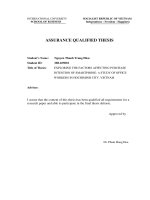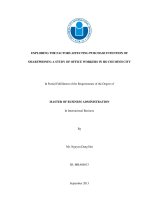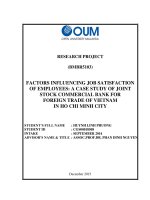DSpace at VNU: Epidemiological features and risk factors of Salmonella gastroenteritis in children resident in Ho Chi Minh City, Vietnam
Bạn đang xem bản rút gọn của tài liệu. Xem và tải ngay bản đầy đủ của tài liệu tại đây (248.14 KB, 10 trang )
Epidemiol. Infect. (2013), 141, 1604–1613. f Cambridge University Press 2012
doi:10.1017/S0950268812002014
Epidemiological features and risk factors of Salmonella
gastroenteritis in children resident in Ho Chi Minh City, Vietnam
C. N. T H O M P S O N 1,2, V. T. M. P HA N 2, T. P. T. L E 2, T. N. T. P HA M 3, L. P. HO A NG 4,
V. HA 5, V. M. H. N GU Y E N 2, V. M. P H A M 2, T. V. NG UY E N 2, T. T. C A O 2,
T. T. N. T R A N 2, T. T. H. NG UY E N 3, M. T. DA O 6, J. I. C A M P B E LL 1,2,
T. C. NG UY EN 5, C. T. T A N G 5, M. T. H A 4, J. F A R R A R 1,2 A N D S. B A KE R 1,2*
1
Centre for Tropical Medicine, Nuffield Department of Clinical Medicine, Oxford University, Oxford, UK
Hospital for Tropical Diseases, Wellcome Trust Major Overseas Programme, Oxford University Clinical
Research Unit, Ho Chi Minh City, Vietnam
3
Children’s Hospital 2, Ho Chi Minh City, Vietnam
4
Children’s Hospital 1, Ho Chi Minh City, Vietnam
5
Hospital for Tropical Diseases, Ho Chi Minh City, Vietnam
6
Geomatics Center, Vietnam National University, Ho Chi Minh City, Vietnam
2
Received 21 December 2011; Final revision 12 July 2012; Accepted 13 August 2012;
first published online 25 September 2012
SUMMARY
Non-typhoidal Salmonella are an important but poorly characterized cause of paediatric
diarrhoea in developing countries. We conducted a hospital-based case-control study in children
aged <5 years in Ho Chi Minh City to define the epidemiology and examine risk factors
associated with Salmonella diarrhoeal infections. From 1419 diarrhoea cases and 571 controls
enrolled between 2009 and 2010, 77 (5.4 %) diarrhoea cases were stool culture-positive for
non-typhoidal Salmonella. Salmonella patients were more likely to be younger than controls
(median age 10 and 12 months, respectively) [odds ratio (OR) 0.97; 95 % confidence interval (CI)
0.94–0.99], to report a recent diarrhoeal contact (8.1% cases, 1.8 % controls; OR 5.98,
95 % CI 1.8–20.4) and to live in a household with >2 children (cases 20.8 %, controls 10.2% ;
OR 2.32, 95% CI 1.2–4.7). Our findings indicate that Salmonella are an important cause of
paediatric gastroenteritis in this setting and we suggest that transmission may occur through
direct human contact in the home.
Key words: Bacterial infections, epidemiology, paediatrics, Salmonella.
INTRODUCTION
Diarrhoea is the second leading cause of death in
children aged <5 years globally with an estimated 2.5
billion cases and 1.5 million deaths in this key age
* Author for correspondence : Dr S. Baker, Enteric Infections
Group, Hospital for Tropical Diseases, Wellcome Trust Major
Overseas Programme, Oxford University Clinical Research Unit,
764 Vo Van Kiet, District 5, Ho Chi Minh City, Vietnam.
(Email : )
group annually [1]. Developing countries bear the
brunt of diarrhoeal disease burden in both mortality
and morbidity [2, 3]. The non-typhoidal members
of the bacterial genus Salmonella (i.e. excluding
Salmonella Typhi and Salmonella Paratyphi pathovars) represent a significant public health problem in
industrializing and industrialized countries and have
been estimated to account for 1–5% of all cases of
gastroenteritis in the former group [3, 4]. However the
The online version of this article is published within an Open Access environment subject to the conditions of the Creative Commons
Attribution-NonCommercial-ShareAlike licence < The written permission of
Cambridge University Press must be obtained for commercial re-use.
Paediatric Salmonella gastroenteritis in Vietnam
source and transmission of gastrointestinal nontyphoidal Salmonella infections in developing countries are not well documented [5]. Infants and young
children suffer substantially more from the effects of
Salmonella infections compared to other age groups
and are therefore also at higher risk of secondary
complications [6]. Obtaining local, specific epidemiological data on enteric pathogens such as Salmonella
is crucial to understand and combat paediatric diarrhoea [7].
Vietnam is a rapidly developing country with a
population of more than 88 million people (over seven
million are aged <5 years), a child mortality rate of
24/1000 live births and an average per capita income
of about US$1100 per year [1, 8]. Diarrhoea is the
seventh most common cause of death in children aged
<5 years in Vietnam and accounts for 4 % of the
deaths in this age group per year [9].
To assess important epidemiological aspects of
diarrhoeal disease in children aged <5 years resident
in Ho Chi Minh City, Vietnam, we conducted a large
hospital-based case-control study. Here, we present
results regarding the prevalence, clinical presentation,
treatment and risk factors associated with symptomatic Salmonella diarrhoeal infections in hospitalized
children in this large, urban, industrializing setting.
METHODS
Study sites
This study was conducted at three hospitals in central
Ho Chi Minh City. The Hospital for Tropical
Diseases (HTD) is the tertiary referral hospital for
infectious diseases in Ho Chi Minh City and surrounding provinces in southern Vietnam. Children’s
Hospital 1 (CH1) and Children’s Hospital 2 (CH2)
are the two main paediatric hospitals in Ho Chi Minh
City.
1605
constraints, the first five patients meeting the inclusion criteria from each of the three study sites on
weekdays were included in the study. Children were
excluded if they did not live within Ho Chi Minh City,
had been pre-treated with antimicrobials, had multiple complications unrelated to diarrhoeal disease
or did not have informed consent of the parent or
guardian.
Controls
Controls were children aged <5 years from Ho Chi
Minh City attending the nutrition wards of CH1 and
CH2 from March 2010 to December 2010. Children
who had symptoms of diarrhoea or respiratory illness,
were currently on an antimicrobial regimen, were
aged >60 months, did not live in a district of Ho Chi
Minh City or did not have informed consent of the
parent or guardian were excluded. There was no limit
on the number of controls enrolled daily.
Sample collection and questionnaire
Stool specimens for both cases and controls were
collected on the day of admission to hospital and
prior to any prescribed antimicrobial therapy. All
samples were stored in a refrigerator (4 xC) and were
transported on the same day to the laboratory for
analysis. Treating clinicians were asked to complete a
simple case report form for information on symptoms
and duration of disease. In addition, a short questionnaire was administered to the child’s parent or
guardian by study nurses to gather information on
basic demographics, socioeconomic indicators and
potential risk factors for infection. We additionally
recorded the location of the residences of the children
with Salmonella infections using a GPS receiver.
Addresses were anonymized to ensure patient confidentiality. Climate data was obtained from the
Vietnam Southern Regional Meteorological Station.
Cases
All children aged <5 years with acute diarrhoeal
disease admitted to the Gastrointestinal Department
of CH1, CH2 and HTD from May 2009 to April 2010
in Ho Chi Minh City were eligible for participation in
the study. We defined a case of diarrhoea as o3 loose
stools or at least one bloody loose stool within a 24-h
period. We defined a case of Salmonella infection
as a diarrhoeal infection stool culture-positive for
Salmonella spp. Due to resource and personnel
Microbiology
Stool specimens were cultured on MacConkey agar
(MC, Oxoid), xylose-lysine-deoxycholate agar
(XLD, Oxoid), and selenite broth (Oxoid) media and
incubated at 37 xC overnight. The overnight selenite
broth, which nourished possible Salmonella, was
subcultured on MC and XLD agars for identification
of Salmonella organisms. Identification of potential
Salmonella was performed using conventional
1606
C. N. Thompson and others
biochemical (API 20E biochemical strip tests) according to the standard operating procedure. All isolated pathogens were recorded and kept for future
testing by freeze drying and storage at x20 xC.
Data analysis
Data were entered into a database using Excel 2007
(Microsoft, USA) and analysed using Stata/IC version 9.2 (StataCorp., USA). x2 and Fisher’s exact tests
were used to compare proportions between groups
and Mann–Whitney U tests were used for nonparametric data. Univariate analyses were performed
to assess factors associated with symptomatic nontyphoidal Salmonella infection. Factors found to be
significantly associated with infection in the univariate analysis were then included in a multivariate
logistic regression model to simultaneously control
for any effects of confounding. Evidence of effect
modification was also investigated to determine if the
effect of one exposure on the outcome of Salmonella
infection was influenced by other exposures of
interest. Two-sided P values f0.05 were considered
statistically significant throughout. ArcMap software
version 9.2 (ESRI, USA) was used for geographical
mapping of patient addresses.
Ethics
Informed consent was required from all parents or
guardians for the child to participate in the study.
Ethical approval was granted by the Oxford Tropical
Research Ethics Committee (OxTREC no. 0109) and
the local scientific and ethical committees of the three
participating hospitals.
R ES U L T S
Descriptive characteristics
A total of 1419 children with acute diarrhoea and 571
asymptomatic individuals (without diarrhoea and
with stool samples microbiologically culture negative
for Salmonella) were enrolled between May 2009 and
December 2010 from the three defined healthcare facilities in central Ho Chi Minh City, Vietnam. For 77
(5.4%) diarrhoea cases, patient stool culture yielded
Salmonella on the day of hospital admission and
therefore met the criteria for a Salmonella case. Of
these, 45 (58 %) were serogroup B, ten (13 %) were
serogroup C, five (6 %) were serogroup D, two (3 %)
were S. Arizonae and 15 (20 %) were ungroupable.
Sixty-four per cent of the Salmonella diarrhoeal
cases and 53 % of asymptomatic individuals (referred
hereon as ‘ controls ’) were male (x2 test, P=0.086),
as shown in Table 1. Patients with Salmonella infection were, on average, marginally younger (median
10 months) than controls (median 12 months)
(Mann–Whitney U test, P=0.015), although an equal
proportion (78 %) of Salmonella patients (60/77) and
controls (443/571) were being actively breastfed,
or were breastfed as infants. Information on the
specific duration of breastfeeding was not collected.
Conversely, a greater proportion of controls (70/571,
12 %) were malnourished (weight for age Z score
f–2) [10], compared to Salmonella patients (5/77,
7 %) (P<0.001).
The clinical and treatment characteristics of
Salmonella gastrointestinal infections
Profuse watery diarrhoea was most the commonly
reported form of diarrhoea, found in 45/77 (59 %)
patients with Salmonella infection followed by 26
(34 %) with diarrhoea containing mucus, and six (8 %)
with bloody diarrhoea (Table 2). Mild (37.2–39 xC)
and severe (>39 xC) fever were common, and the
majority of children experienced vomiting. Illness
prior to hospitalization occurred for a median of
2 days [interquartile range (IQR) 2–3] and children
remained in hospital for a median of 5 days (IQR
3–8), with discharge permitted only by a treating
clinician on the observation of the cessation of
symptoms. Attending clinicians prescribed treatment
to Salmonella patients prior to a microbiological stool
investigation or an available antimicrobial susceptibility profile. In total, 67.5% (52/77) of Salmonella
infections were prescribed an antimicrobial by the
attending physician during their hospital stay. Over
half (38/52, 73%) of the prescribed antimicrobials
were fluoroquinolones, of which the most commonly
used were ciprofloxacin (23/52, 44 %) and norfloxacin
(10/52, 19 %). Additionally, rehydration therapy
and probioitic supplements were administered to the
majority of patients (lyophilized probiotics reconstituted in a beverage). Sixty-four per cent (33/52) of
those prescribed antimicrobials were prescribed probiotic therapy concurrently with the antimicrobials.
Seasonality and location
The south of Vietnam has two main seasons : a wet
season from May to November and a humid dry
Paediatric Salmonella gastroenteritis in Vietnam
1607
Table 1. Baseline, socioeconomic and behavioural characteristics of Salmonella diarrhoea cases and asymptomatic
controls aged <5 years from three hospitals in Ho Chi Minh City, Vietnam
Exposure
Salmonella patients
n=77 (%)
Controls
n=571 (%)
Male sex
Breastfed
63.6
77.9
53.2
77.6
Weight for age Z score <–2$
Contact with symptomatic·
Previous illness
24.7
37.7
19.5
5.2
7.8
2.6
2.6
6.5
8.1
14.3
16.8
34.5
19.3
9.8
8.6
5.8
5.3
12.3
1.8
7.0
Residence
Rural
Urban
11.7
88.3
12.4
87.6
Household monthly income
US$243–483
US$484–725
>US$725
16.9
37.7
31.2
7.8
6.5
22.9
34.7
27.3
10.0
5.1
Water source
Government pipe
Well
Other||
Bottled drinking water
Boil water
63.6
28.6
7.8
20.8
89.6
58.7
36.6
4.7
20.1
93.5
Toilet·
Inside
Outside
81.8
11.7
74.4
24.9
33.8
14.9
14.9
36.5
29.9
20.8
14.3
13.7
75.3
24.7
39.8
9.5
6.2
44.7
26.4
10.2
15.4
72.7
57.9
27.2
Age (months)
0–6
7–12
13–18
19–24
25–36
37–48
49–60
Hand washing after using toilet·
Always
Occasionally
No/don’t know
Not applicable"
>4 adults in household
>2 children in household
Daycare/nursery·
History of probiotic usage
Market food·
Pet in household
P#
0.087
0.947
0.379
<0.001*
<0.001*
0.026*
0.852
0.690
0.251
0.953
0.205
0.018*
0.015*
0.524
0.006*
0.773
<0.001*
0.004*
0.646
# x2 or Fisher’s exact test as appropriate.
$ Considered malnourished [10].
· Responses for symptomatic contact from 74 cases, 565 controls ; for toilet use from 72 cases, 567 controls ; for hand
washing from 74 cases, 571 controls ; for daycare/nursery from 77 cases, 566 controls ; for probiotics from 31 cases, 394
controls ; and for market food from 73 cases, 570 controls.
|| Rain water, from a government truck during road construction or other source.
" Child in diapers and therefore would not require hand washing.
* P value f0.05.
1608
C. N. Thompson and others
Table 2. Clinical features of Salmonella infections in
Vietnamese children hospitalized with diarrhoea
(n=77)
Diarrhoea type
Bloody
Mucoid
Watery
n
6
26
45
%
7.8
33.8
58.5
Patient characteristics
Average no. episodes/day
Length of illness*, days
Length of stay in hospital, days
Median
5
2
5
IQR
3–8
2–3
3–8
Symptoms
Fever
Abdominal pain
Anorexia
Cough
Dehydration
Headache
Vomiting
n
58
13
35
22
5
1
50
%
75.4
16.9
45.5
28.6
6.5
1.3
64.9
IQR, Interquartile range.
* Prior to hospitalization.
season from December to April. The proportion of
diarrhoea cases presenting to hospital that had a
culture-confirmed diagnosis for Salmonella was the
highest in August (12/193, 12.9 %) and the lowest in
February (2/80, 2.3 %). We did not identify a strong
association between Salmonella infections and average
monthly temperature (Spearman’s correlation coefficient r=0.389, P=0.080) and there appeared to be no
association between Salmonella infection and average
monthly rainfall (Spearman’s r=0.14, P=0.665). The
GPS coordinates of each case were plotted and case
counts per district revealed the highest proportion
of Salmonella patients (12/77, 16%) lived in district
8 in Ho Chi Minh City (Fig. 1a). However, when
comparing the ratio of Salmonella cases to cases of
diarrhoea caused by other bacterial or viral agents
collected for 2009–2010 (Fig. 1b), less centrally located districts such as district 11, Tan Binh and Binh
Thanh seemed to have proportionally heavier burdens of Salmonella infection with ratios of Salmonella
culture-positive diarrhoeal cases to culture-negative
cases of 0.18 (7/39), 0.15 (8/52) and 0.13 (9/69), respectively.
Socioeconomic and behavioural characteristics
Responses from the questionnaire administered to the
parents/guardians of both cases and controls were
evaluated to determine trends in socioeconomic or
behavioural factors in the overall population as well
as any important differences between the two groups.
From the resulting questionnaire data, a low proportion of children reported having been in recent
contact with an individual symptomatic for diarrhoea
or a recent previous diarrhoeal episode, although
children with Salmonella infection were more likely to
have reported both (Table 1). In regard to sanitation
and water supply, over half of Salmonella patients
(49/77, 64 %) and controls (335/571, 59 %) used a
municipal government pipeline, which was followed
less commonly by wells, 29 % (22/77) and 37 % (209/
571), respectively. Roughly 20% of children with
Salmonella infection (16/77) and controls (117/571)
reported drinking only bottled water, while almost
all Salmonella patients (69/77, 90%) and controls
(534/571, 94 %) reported boiling their water prior
to drinking. Hand washing behaviour differed between the groups, with those positive for Salmonella
more commonly reporting not washing hands or
not knowing if hands were washed (36/71, 15%)
than controls (35/571, 6%). Yet surprisingly,
Salmonella patients were more likely to have an indoor toilet (63/72, 82 %) compared to controls (142/
567, 74 %).
In order to assess general living conditions, we
evaluated the level of household crowding by
measuring the proportion of Salmonella patients and
controls who reported having more than the median
number of adults (n=4) and children (n=2) in the
household, as estimated from our larger population of
1419 diarrhoeal cases and 571 controls. The households of y30 % of Salmonella patients (23/77) and
controls (151/571) had more than four adults yet the
patients’ households had greater than the median
of two children more frequently (16/77, 21 %) than
controls’ households (57/571, 10%). Additionally,
monthly income distributions were comparable between Salmonella patients and controls, with the
majority of households (cases and controls) having an
income of between US$145 and US$480 per month.
More children with Salmonella reported living in
households regularly purchasing meat and vegetables
from outdoor markets (55/73, 75%) compared to only
58 % (330/570) of controls. Pet ownership (mainly cats
and dogs), was y25 % in children with Salmonella
infection (19/77) and controls (155/571). Finally,
Salmonella patients reported regularly consuming
probiotics prior to diarrhoea much less frequently
(7/51, 14%) than controls (280/440, 64 %).
Paediatric Salmonella gastroenteritis in Vietnam
(a)
Hoc Mon
D12
Thu Duc
Go Vap
D12
D9
Binh Thanh
Tan Binh
Phu Nhuan
Binh Chanh
Tan Phu
D3
D10
Binh Tan
D2
D1
D11
D4
D5
<3%
D6
3–6%
6–9%
D7
D8
9–12%
Binh Chanh
>12%
(b)
Nha Be
0
Hoc Mon
3
1·5
6 km
D12
Thu Duc
Go Vap
D12
D9
Binh Thanh
Tan Binh
Phu Nhuan
Binh Chanh
Tan Phu
D3
D10
Binh Tan
0·04–0·06
D2
D1
D11
D5
0–0·02
0·02–0·04
1609
D4
D6
D7
D8
0·06–0·12
0·12–0·18
N
Binh Chanh
Nha Be
Fig. 1 [colour online]. The geographical distribution of Salmonella cases in children aged <5 years admitted to the three
study hospitals in central Ho Chi Minh City. The hospital locations are as follows : Children’s Hospital 1 ; Children’s
Hospital 2 ; Hospital for Tropical Diseases. (a) Proportion of total Salmonella cases from each district ; (b) Ratio of cases of
Salmonella to cases of another bacterial or viral aetiology.
Exposure analysis
Symptomatic Salmonella gastrointestinal infection
was associated with having contact with a recently
symptomatic individual [odds ratio (OR) 4.90, 95 %
confidence interval (CI) 1.7–13.9], living in a household where meat and vegetables were primarily purchased at an outdoor market (OR 2.22, 95 % CI
1.3–3.9), recent previous diarrhoeal illness (OR 2.21
95 % CI 1.1–4.5), not washing hands or not knowing
if hands were washed after using the toilet (OR 2.67,
95 % CI 1.3–5.5), age (OR 0.98, 95 % CI 0.96–1.00)
and having >2 children living in the household
(OR 2.32, 95% CI 1.2–4.8). The type of toilet (indoor/
outdoor) present in the household was also found
to be important. Living in an urban or rural district
modified the effect of toilet type on the risk of contracting a Salmonella infection (test for homogeneity
of ORs, P=0.038) such that living in a household
with an outdoor toilet was not a risk factor in rural
districts (OR 2.41, 95 % CI 0.6–9.1), whereas it appeared to be strongly protective for those living in
1610
C. N. Thompson and others
Table 3. Selected univariate and multivariate analysis
of risk factors for symptomatic Salmonella
gastroenteritis
Risk factor
OR
95 % CI
aOR 95 % CI
Previous illness
Symptomatic contact
Age (months)
Absence of hand
washing
Purchasing market
food
>2 children in
household
2.21
3.14
0.98
2.67
1.08–4.52
1.12–8.83
0.96–1.00
1.29–5.53
1.77
5.98
0.97
1.99
Outside toilet
Urban
Rural
0.73–4.26
1.76–20.36
0.94–0.99
0.85–4.63
2.22 1.27–3.88 2.27
1.22–4.24
2.32 1.26–4.29 2.32
1.15–4.67
0.27 0.11–0.70 0.25
1.67 0.41–6.81 1.53
0.09–0.72
0.30–7.86
OR, Odds ratio ; C, : Confidence interval ; aOR, adjusted
odds ratio.
urban districts (OR 0.24, 95 % CI 0.1–0.6). Probiotics
also demonstrated a protective effect (OR 0.09, 95 %
CI 0.04–0.22).
After controlling for the factors that were found to
be statistically significant in the univariate analysis as
listed above, several risk factors remained independently associated with Salmonella infections in the
multivariate model (Table 3). These risk factors
included having had a symptomatic contact [adjusted
OR (aOR) 5.98, 95% CI 1.8–20.4], age (aOR 0.97,
95 % CI 0.94–0.99), living in a household where meat
and vegetables were primarily purchased at an outdoor market (aOR 2.27, 95 % CI 1.2–4.2), having >2
children in the household (aOR 2.32, 95 % CI
1.2–4.4.7) individuals with an outdoor toilet living in
predominantly urban districts (aOR 0.25, 95 % CI
0.09–0.72).
D IS C U SS I ON
The epidemiology of gastrointestinal infections
caused by Salmonella has been extensively studied in
developed countries but there is a paucity of data regarding the prevalence and potential transmission
routes of Salmonella in developing countries. This is
the first study to exclusively evaluate the epidemiology and risk factors of non-typhoidal Salmonella
gastrointestinal infections in children in Vietnam.
We found that fever, anorexia, vomiting and either
watery or mucoid diarrhoea were all common features
of patients with Salmonella infections, which are
typical globally of Salmonella infection presentation
[5]. Cases of Salmonella were not found to be associated with average monthly temperature in Ho Chi
Minh City, although there was a proportional increase
during the warmer months of the year. Previous
studies conducted in the UK and Australia have
shown that a higher mean ambient temperature leads
to an increase in the number of salmonellosis notifications, possibly through an increase in bacterial reproduction at various points along the food chain
[11, 12]. Although, whether their findings are an important transmission factor in a developing-country
setting remains unclear currently.
Additionally, although it is important to consider
that our geographical data is biased as a consequence
of hospital referral patterns, the highest proportion of
Salmonella patients came from district 8 of Ho Chi
Minh City. This district is the area of the city with the
greatest density of canals, waterways and is one of the
districts with the largest number of temporary urban
settlements [13]. Proximity to potentially contaminated water and related poor sanitary conditions may
explain the high proportion of Salmonella infections
from persons living in this area.
With respect to our controls, young children with
Salmonella infections were more likely to have had a
symptomatic contact, to be younger, to live in a
household where food is purchased primarily at an
outdoor market, to live with at least three children
in the household and were more likely to use an outdoor rather than an indoor toilet in urban areas. Our
findings regarding the young age of infection are
consistent with other studies, which have shown that
younger children are at greater risk, and have more
frequent Salmonella infections than children in older
age groups [14]. The majority of Salmonella infections
in this study were from infants aged <1 year, with the
peak of infections in those aged between 7 and
12 months. Potential reasons for increased susceptibility to Salmonella infections include numerous
host factors, such as decreased gastric acidity, immaturity of the gut-associated lymphoid tissue or a
lack of serogroup-specific maternal antibodies [14].
Additionally, research conducted in Malawi has
demonstrated that children aged between 4 months
and 2 years are at increased risk of invasive nontyphoidal Salmonella infection due in part to a lack
of Salmonella-specific antibody, impaired bactericidal
activity and waning maternal IgG [15, 16], although
mechanisms may differ for disease limited to the
gastrointestinal tract.
Paediatric Salmonella gastroenteritis in Vietnam
Previous studies have identified Salmonella in the
environment of patients with recently identified infections and that multiple cases of the same Salmonella
strain may occur in the same household, suggesting
the potential for intra-household transmission [17–19].
In a large case-control study using hospital laboratory
reports in the USA from 2002 to 2004, Jones et al.
found that 20 % of households with a primary
Salmonella spp. infection reported a subsequent case
[6]. However, having had contact with a symptomatic
individual is difficult to interpret as it is often unclear
if the contact had the same infection, if the period of
infectiousness of the contact coincides with the timing
of the patient’s illness and whether a shared exposure
is responsible for the association. We observed that
cases were more likely to have several children living
in the same household, which has also been shown to
be a risk factor in studies of other enteric pathogens
in the Congo and Bangladesh [20, 21]. It is reasonable
to suggest that multiple children living in a single
household may lead to an increase in the frequency of
Salmonella transmission, as children aged <5 years
are more likely to be infected and also tend to shed
asymptomatically for protracted time periods which
would broaden the potential transmission window
[22]. The possibility of different primary patterns
of Salmonella transmission by age warrants more
attention.
Although multiple investigations have demonstrated that a considerable proportion of Salmonella
spp. transmission occurs through the food chain [3],
direct person-to-person Salmonella transmission has
been implicated as a more important transmission
route in some non-industrialized countries [23]. We
found that living in a household where food was
purchased at outdoor markets was a risk factor, a
consequence of substandard food handling, storage
and preparation practices at such settings. Very
young children are less likely to eat solid food, so it is
likely that a primary risk factor for symptomatic
Salmonella is by a direct exposure from either the
contaminated environment or family members, not
specific food products [6]. Therefore, ensuring a clean
local environment and adequate personal hygiene
of caregivers are critical prevention measures to limit
symptomatic Salmonella infections in very young
children in this population.
Antimicrobials are not universally recommended
for the treatment of gastrointestinal non-typhoidal
Salmonella infections specifically or for treating
non-bloody diarrhoea in children in general [24].
1611
Treatment with antimicrobials is only advised for
children with suspected or confirmed septicaemia or
additional secondary complications [25]. Almost 70 %
of the Salmonella-infected individuals in this study
received at least one antimicrobial, most commonly a
fluoroquinolone, which contradicts internationally
recognized guidelines. In fact, some data suggest that
antimicrobials may actually prolong shedding of the
pathogen in the stool [22], and will presumably
increase the potential for the development of antimicrobial resistance. Resistance has implications for
treatment failure, increasing treatment costs and
protracted therapy for infections that do require an
antimicrobial, as second-line drugs are often more
expensive and typically require a longer treatment
[26]. Furthermore, the treating clinicians prescribed
probiotics to over 60 % of Salmonella-infected
patients, with almost half of the patients concurrently
receiving probiotics and antimicrobials. Diagnostics
are seldom performed for diarrhoea in settings like
Vietnam and patients are prescribed therapy based on
clinical presentation and prior to microbiological
culture result. More stringent treatment guidelines
and the restriction of access to antimicrobials in the
community would help to ensure more appropriate
antimicrobial practices.
Our analysis suggests that probiotics have a significant prophylactic effect against symptomatic
Salmonella in this study. In Vietnam, probiotics vary
substantially but generally consist of a lyophilized
Lactobacillus spp. in a single-dose sachet, which is
normally reconstituted in water or milk prior to consumption. The use of probiotics was not included
in the multivariate model due to possible biases introduced by limitations in study design. As controls
were collected from the nutritional ward, parents of
these children may have been likely to give their child
a product supplemented with probiotics (very popular
and inexpensive in Vietnam) in a specific effort to care
for the nourishment of their child. Parents of diarrhoeal patients may have been less concerned with
nutritional issues and therefore may have been
less likely to give their child probiotics. However, the
strong effect found in the univariate model warrants
further scrutiny. A recent large community-based,
randomized, double-blind, placebo-controlled trial
was conducted in an urban settlement in Kolkata,
India, demonstrating that a daily intake of probiotics
resulted in significant protection against acute diarrhoea in children aged <5 years with an overall protective efficacy of 14 % (95 % CI 4–23%, P<0.01)
1612
C. N. Thompson and others
[27]. These results are positive, as this was the first
large, randomized controlled trial for a prophylactic
effect of probiotics conducted in a developing country.
A recent Cochrane review regarding the use of probiotics for treating acute diarrhoea found probiotics
to be associated with a reduction in risk and duration
of diarrhoeal diseases in children [28], adding additional plausibility to our observation.
There were several limitations to our study, the
most important of which is that this data was entirely
from passive detection and was dependent on the
healthcare-seeking behaviour of the patients. As such,
much of the burden of infection due to Salmonella
could remain undocumented, including those less
severe cases that did not require medical care.
Uncollected differences could have been present between the cases and controls as well, as controls were
only collected from two hospitals due to logistical
reasons. Selection bias may also have been present as
controls were collected from nutrition wards. We
found that these individuals were more likely to have
a lower weight-for-age Z score than the cases which
could potentially introduce biases as nutritional state
tends to play a strong role in susceptibility to diarrhoeal infections and could skew noted epidemiological associations through influences of unknown
confounders [29]. Or it is possible that controls were
likely to have already acquired Salmonella infection
which could have contributed to their poor nutritional status.
We surmise that while our findings should be generalized with caution, our study provides a reasonable
estimate of the proportion of Salmonella-associated
diarrhoea in hospitalized children and highlights
some related risk factors for children resident in Ho
Chi Minh City. Our findings imply that Salmonella is
a common cause of paediatric gastroenteritis in this
setting and that transmission may occur through
direct human contact within the household, offering
some palpable and tractable prospective routes for
more focused epidemiological investigations in locations in other rapidly developing cities in Asia.
ACKNOWLEDGEMENTS
We thank the clinical staff of the Hospital for
Tropical Diseases, Children’s Hospital 1 and
Children’s Hospital 2 in Ho Chi Minh City for their
efforts in conducting this work and the individuals
enrolled in the study. We especially acknowledge the
efforts of the microbiology laboratories at the
Hospital for Tropical Diseases in Ho Chi Minh City,
Vietnam. This work was supported through funding
from the Wellcome Trust Visions Initiative (UK), the
Li Ka Shing foundation (People’s Republic of China)
and a fellowship (S.B.) from the OAK Foundation
(USA) through Oxford University, UK. The funders
had no role in study design, data collection and
analysis, decision to publish, or preparation of the
manuscript.
D E C L A R A T I O N O F IN T E R E S T
None.
REFERENCES
1. UNICEF/WHO. Diarrhoea : why children are still
dying and what can be done. Geneva : The United
Nations Children’s Fund/World Health Organization,
2009. Report no. : NLM : WS312.
2. Thapar N, Sanderson PIR. Diarrhoea in children : an
interface between developing and developed countries.
Lancet 2004 ; 363 : 641–653.
3. Zaidi MB, et al. Nontyphoidal Salmonella from human
clinical cases, asymptomatic children, and raw retail
meats in Yucatan, Mexico. Clinical Infectious Diseases
2006 ; 42 : 21–28.
4. WHO. The Treatment of Diarrhoea : A Manual for
Physicians and Other Senior Health Workers, 4th revision. Geneva : World Health Organization, 2005.
Report No. : WHO/CDD/SER/80.2.
5. Graham SM. Salmonellosis in children in developing
and developed countries and populations. Current
Opinion in Infectious Diseases 2002 ; 15 : 507–512.
6. Jones TF, et al. A case-control study of the epidemiology of sporadic Salmonella infection in infants.
Pediatrics 2006 ; 118 : 2380–2387.
7. Bodhidatta L, et al. Rotavirus disease in young children
from Hanoi, Vietnam. Pediatric Infectious Disease
Journal 2007 ; 26 : 325–328.
8. World Bank. The World Bank : gross national income
per capita (Vietnam), 2009 ( />country/vietnam). Accessed 11 March 2012.
9. WHO. World Health Organization : Viet Nam health
profile, 2011 ( />Accessed 15 March 2012.
10. Albert MJ, et al. Case-control study of enteropathogens associated with childhood diarrhea in Dhaka,
Bangladesh. Journal of Clinical Microbiology 1999 ; 37 :
3458–3464.
11. D’Souza RM, et al. Does ambient temperature
affect foodborne disease ? Epidemiology 2004 ; 15 :
86–92.
12. Lake IR, et al. A re-evaluation of the impact of temperature and climate change on foodborne illness.
Epidemiology and Infection 2009 ; 137 : 1538–1547.
Paediatric Salmonella gastroenteritis in Vietnam
13. Habitat for Humanity. Mapping urban poverty in
Ho Chi Minh City, Vietnam, 2009 (http://www.
habitatvietnam.org/). Accessed 16 February 2012.
14. Shimoni Z, et al. Nontyphoid Salmonella bacteremia :
age-related differences in clinical presentation, bacteriology, and outcome. Clinical Infectious Diseases 1999 ;
28 : 822–827.
15. MacLennan CA, et al. The neglected role of antibody in
protection against bacteremia caused by nontyphoidal
strains of Salmonella in African children. Journal of
Clinical Investigation 2008 ; 118 : 1553–1562.
16. Gondwe EN, et al. Importance of antibody and complement for oxidative burst and killing of invasive
nontyphoidal Salmonella by blood cells in Africans.
Proceedings of the National Academy of Sciences USA
2010 ; 107 : 3070–3075.
17. Barker J, Bloomfield SF. Survival of Salmonella in
bathrooms and toilets in domestic homes following
salmonellosis. Journal of Applied Microbiology 2000 ;
89 : 137–144.
18. Schutze GE, et al. The home environment and
salmonellosis in children. Pediatrics 1999 ; 103 : e1–e5.
19. Ethelberg S, et al. Household outbreaks among
culture-confirmed cases of bacterial gastrointestinal
disease. American Journal of Epidemiology 2004 ; 159 :
406–412.
20. Manun’Ebo MN, et al. Influence of demographic,
socioeconomic and environmental variables on childhood diarrhoea in a rural area of Zaire. Journal of
Tropical Medicine and Hygiene 1994 ; 97 : 31–38.
1613
21. Pathela P, et al. Diarrheal illness in a cohort of children
0–2 years of age in rural Bangladesh : I. Incidence and
risk factors. Acta Pædiatrica 2006 ; 95 : 430–437.
22. Hohmann EL. Nontyphoidal salmonellosis. Clinical
Infectious Diseases 2001 ; 32 : 263–269.
23. Feasey NA, et al. Typhoid fever and invasive nontyphoid salmonellosis, Malawi and South Africa.
Emerging Infectious Diseases 2010 ; 16 : 1448–1451.
24. Sirinavin S, Garner P. Antibiotics for treating Salmonella gut infections. Cochrane Database of Systematic
Reviews 2009, Issue No. 2, Art. No. : CD001167.
25. Khanna R, et al. Diarrhoea and vomiting caused by
gastroenteritis in children under 5 years : summary of
NICE guidance. British Medical Journal 2009 ; 338 :
1009–1012.
26. Travers K, Michael B. Morbidity of infections caused by
antimicrobial-resistant bacteria. Clinical Infectious Diseases 2002 ; 34 : S131–134.
27. Sur D, et al. Role of probiotic in preventing acute
diarrhoea in children : a community-based, randomized,
double-blind placebo-controlled field trial in an urban
slum. Epidemiology and Infection 2010 ; 1 : 1–8.
28. Allen SJ, et al. Probiotics for treating infectious diarrhoea. Cochrane Database of Systematic Reviews 2004,
Issue No. 11, Art. No. : CD003048.
29. Schlaudecker EP, Steinhoff MC, Moore SR. Interactions of diarrhea, pneumonia, and malnutrition in
childhood : recent evidence from developing countries.
Current Opinion in Infectious Diseases 2011 ; 24 : 496–
502.



